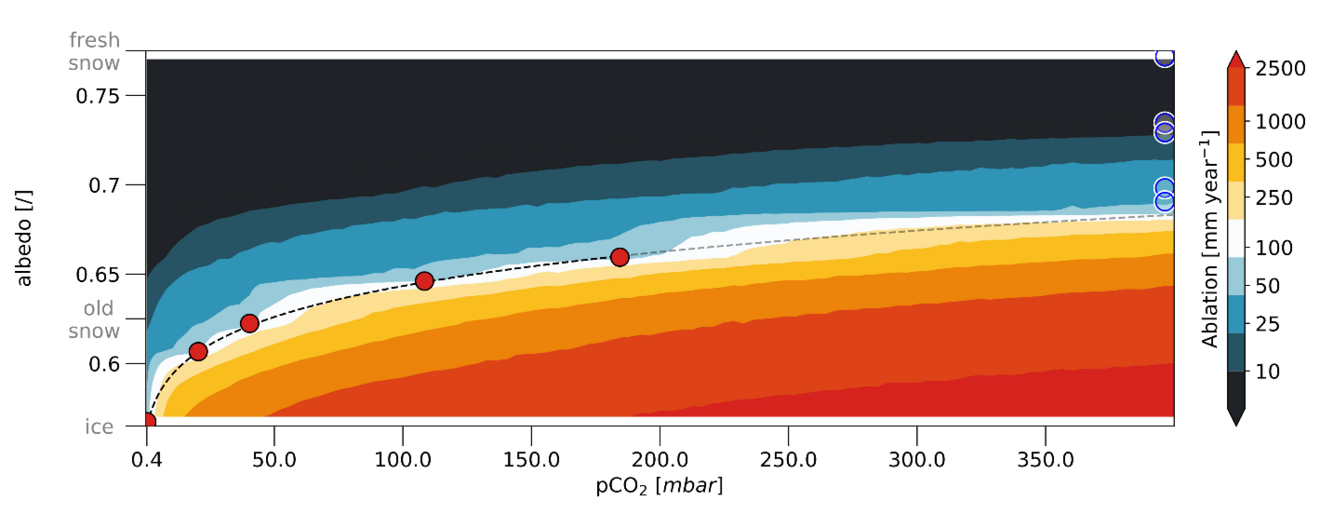Could the deglaciation of Snowball Earth have started in the mid-latitudes?

Geological evidence suggests that Earth’s past featured ice-ages so pronounced that they resulted in a global glaciation, a state termed ”snowball Earth”. But while there is consensus that such extreme icehouse-states occurred repeatedly, it has long been debated whether they featured a complete ice cover, or whether they retained some open ocean surfaces. One challenge to the hypothesis of a complete glaciation comes from the difficulties in explaining how Earth could have left the snowball-state once it had been established. The high reflectivity of its surface may have prevented a snowball Earth from absorbing enough energy to initiate terminal deglaciation, despite atmospheric CO2-concentrations of up to 100 mbar. Triggering deglaciation at plausible CO2-levels would have required surface albedos of less than 0.65, which is substantially lower than the albedo of fresh snow (Fig. 1).
To investigate the processes that modulate the surface albedo on a frozen planet, the authors equipped the MPI-M’s Earth system model with a new snow-albedo scheme remarking that: “The question how Earth could have gotten out of one of the most extreme climate states possible was extremely intriguing. So we feel very lucky to have a tool as versatile as the MPI-ESM, which doesn’t only allow us to look at Earth’s potential future but also millions of years into its past”. With their simulations, they demonstrate that high dust deposition fluxes could have lowered the surface reflectivity enough to initiate the melting of the planet’s ice cover at plausible atmospheric CO2 concentrations. For extreme dust deposition rates – 10 times the present-day fluxes – deglaciation could have been initiated even at today’s CO2 levels. However, contrary to the prevailing theory, their results indicate that deglaciation would not have started in the tropics, but in the mid-latitudes.
In the tropics, a strong hydrological cycle constantly regenerates fresh snow at the surface, which limits the dust accumulation and snow aging, maintaining a high albedo. Instead, comparatively low precipitation rates in the mid-latitudes in combination with high maximum temperatures facilitate lower albedos and snow dynamics that trigger deglaciation at comparatively low carbon dioxide levels. These results are not only relevant for understanding Earth’s history but also hold implications for other solar systems. For example, the outer-edge of the habitable zone is characterized by snowball-like states on rocky, water-rich planets. Depending upon the tectonic mode of the planet and its volcanic CO2 rates, the potential for a mid-latitude deglaciation expands the outer limit for life-bearing planets.
Original publications:
de Vrese, P., Stacke, T., Caves Rugenstein, J., Goodman, J., & Brovkin, V. (2021) Snowfall-albedo feedbacks could have led to deglaciation of Snowball Earth starting from mid-latitudes. Commun. Earth Environ. Doi: 10.1038/s43247-021-00160-4
Contact:
Dr. Philipp de Vrese
Max Planck Institute for Meteorology
Email: philipp.de-vrese@mpimet.mpg.de
Prof. Victor Brovkin
Max Planck Institute for Meteorology, also Center for Earth System Research and Sustainability, University of Hamburg
Email: victor.brovkin@mpimet.mpg.de
Dr. Tobias Stacke
Helmholtz-Zentrum Hereon
Email: tobias.stacke@hereon.de
